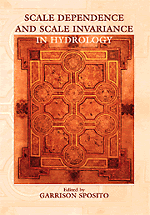Book contents
- Frontmatter
- Contents
- List of Contributors
- Preface
- 1 Scale Analyses for Land-Surface Hydrology
- 2 Hillslopes, Channels, and Landscape Scale
- 3 Scaling in River Networks
- 4 Spatial Variability and Scale Invariance in Hydrologic Regionalization
- 5 An Emerging Technology for Scaling Field Soil-Water Behavior
- 6 Scaling Invariance and the Richards Equation
- 7 Scaling of the Richards Equation and Its Application to Watershed Modeling
- 8 Scale Issues of Heterogeneity in Vadose-Zone Hydrology
- 9 Stochastic Modeling of Scale-dependent Macrodispersion in the Vadose Zone
- 10 Dilution of Nonreactive Solutes in Heterogeneous Porous Media
- 11 Analysis of Scale Effects in Large-Scale Solute-Transport Models
- 12 Scale Effects in Fluid Flow through Fractured Geologic Media
- 13 Correlation, Flow, and Transport in Multiscale Permeability Fields
- 14 Conditional Simulation of Geologic Media with Evolving Scales of Heterogeneity
- Index
13 - Correlation, Flow, and Transport in Multiscale Permeability Fields
Published online by Cambridge University Press: 18 January 2010
- Frontmatter
- Contents
- List of Contributors
- Preface
- 1 Scale Analyses for Land-Surface Hydrology
- 2 Hillslopes, Channels, and Landscape Scale
- 3 Scaling in River Networks
- 4 Spatial Variability and Scale Invariance in Hydrologic Regionalization
- 5 An Emerging Technology for Scaling Field Soil-Water Behavior
- 6 Scaling Invariance and the Richards Equation
- 7 Scaling of the Richards Equation and Its Application to Watershed Modeling
- 8 Scale Issues of Heterogeneity in Vadose-Zone Hydrology
- 9 Stochastic Modeling of Scale-dependent Macrodispersion in the Vadose Zone
- 10 Dilution of Nonreactive Solutes in Heterogeneous Porous Media
- 11 Analysis of Scale Effects in Large-Scale Solute-Transport Models
- 12 Scale Effects in Fluid Flow through Fractured Geologic Media
- 13 Correlation, Flow, and Transport in Multiscale Permeability Fields
- 14 Conditional Simulation of Geologic Media with Evolving Scales of Heterogeneity
- Index
Summary
Introduction
Flow and transport processes in natural soils and rocks traditionally have been described by means of partial differential equations (PDEs). These equations generally are taken to represent basic physical principles (conservation and constitutive laws) that operate on some macroscopic scale (theoretical support volume) at which the geologic medium can be viewed as a continuum. The precise nature of this the-oretical macroscopic support scale remains generally unclear, though some derive comfort from associating it in the abstract with a “representative elementary volume” (REV). Unfortunately, the concept of an REV is equally difficult to define without ambiguity and to apply in practice. Flow and transport PDEs are local in the sense that all quantities (parameters; forcing functions, including initial, boundary, and source terms; dependent variables) that enter into them are defined at a single point (x, t) in space–time. Parameters such as permeability, porosity, and dispersivity are generally regarded as macroscopic medium properties that are well defined and thus can be determined (at least in principle) experimentally, and more or less uniquely, at any point x in the flow domain.
In reality, geologic media are heterogeneous and exhibit both discrete and continuous spatial variations on a multiplicity of scales, and therefore it can be anticipated that the flow and transport properties of these media will exhibit similar variations. Indeed, one manifestation of such variations is the observed and well-documented dependence of permeabilities and dispersivities on their scale of measurement (support volume). Figure 13.1 shows two superimposed profiles for hydraulic conductivity K as determined by packer tests in a single borehole that penetrated fractured granitic rocks at the Finnsjön site in Sweden.
- Type
- Chapter
- Information
- Scale Dependence and Scale Invariance in Hydrology , pp. 354 - 397Publisher: Cambridge University PressPrint publication year: 1998
- 6
- Cited by



